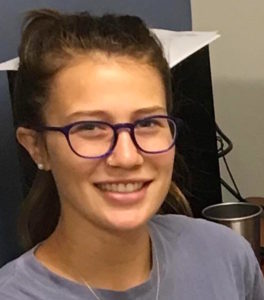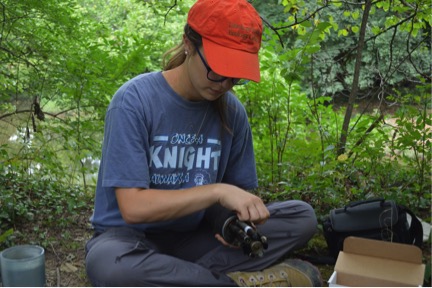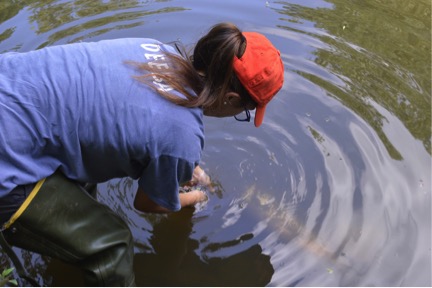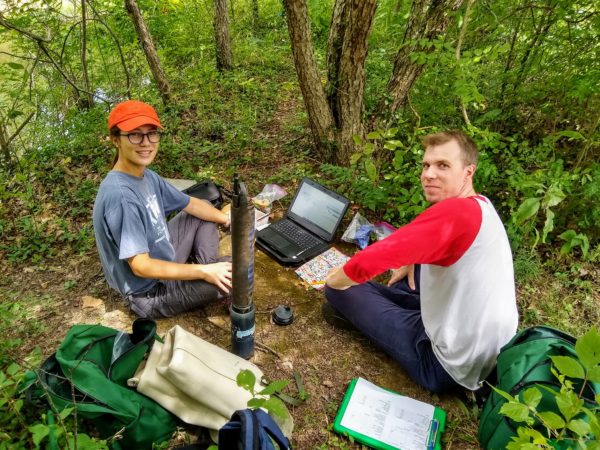
Post written by graduate student Emily Deeba.
As I check how much rain fell at the volunteer cabin from a storm the previous night, I hear a school bus pull into the LREC parking lot; a swarm of elementary school students quickly became the only noise audible in the prairie, but I remained focused documenting the volume of rain and collecting a sample in a glass vial to run back in our laboratory at Saint Louis University (SLU). I see a small group of children being led by a Volunteer Educator out of the corner of my eye, and I overhear the tail end of the volunteer’s explanation to what this strange woman in cargo pants is doing crouched with a notebook, scribbling away furiously:
“That’s one of our scientists studying the water at our stream, Deer Creek.”
I looked up and said hello to the group, and although the group quickly passed me by for the rest of their visit, the volunteer’s comment stayed on my mind for the rest of the day as I finished up at LREC. After completing my undergraduate college degree in Earth and Atmospheric Science at Saint Louis University, and now wrapping up my last year of graduate school, it shouldn’t surprise me when I’m called a scientist (or, more particularly, a geoscientist). There’s this concept that scientists grow on trees or pop up after lightning strikes, as aloof creatures that wear funny plastic glasses and pristine white coats, and a limitless amount of information in their brain. While this stereotype is partially true (however, our lab coats are hardly pristine), becoming a scientist is something I achieved over time, as I developed a specialized set of skills. Just like teachers learn how to lesson plan, and engineers learn to build buildings and bridges, scientists develop the ability to collect information from the environment to discern how and why things happen the way they do. No one’s born with these skills, but we often only see the completed project and not the winding path it took to get there.
 I recall one of my first stepping stones as an environmental scientist during my second year of college. We were covering the topic of groundwater in one of my introduction-level courses. Most people are aware that groundwater exists, but I realized I had a fundamentally flawed way of thinking about this natural resource. Whereas I had always thought of groundwater as water stored in underground caves, it really is more commonly like a saturated sponge, with the sponge really being some porous rock, like sandstone. This rock holds water in the spaces between individual grains that make up the rock. One of the first skills a scientist achieves is the ability to be open minded when information is presented, and to be able to recognize when your way of thinking isn’t the way things really are. While I was wrong in my way of understanding the basics of what groundwater was, instead of being put off the topic because I was incorrect, I became enthralled in learning more about this elusive, massive amount of water trapped beneath the earth’s surface. Even more so, groundwater was of particular interest to me, and likely to many other people, because I grew up relying on a well for my drinking water. It amazed me that I had relied on this resource my whole life, but never really appreciated or understood the definition and process of what groundwater was.
I recall one of my first stepping stones as an environmental scientist during my second year of college. We were covering the topic of groundwater in one of my introduction-level courses. Most people are aware that groundwater exists, but I realized I had a fundamentally flawed way of thinking about this natural resource. Whereas I had always thought of groundwater as water stored in underground caves, it really is more commonly like a saturated sponge, with the sponge really being some porous rock, like sandstone. This rock holds water in the spaces between individual grains that make up the rock. One of the first skills a scientist achieves is the ability to be open minded when information is presented, and to be able to recognize when your way of thinking isn’t the way things really are. While I was wrong in my way of understanding the basics of what groundwater was, instead of being put off the topic because I was incorrect, I became enthralled in learning more about this elusive, massive amount of water trapped beneath the earth’s surface. Even more so, groundwater was of particular interest to me, and likely to many other people, because I grew up relying on a well for my drinking water. It amazed me that I had relied on this resource my whole life, but never really appreciated or understood the definition and process of what groundwater was.
 Today, my master’s research involves studying how groundwater is pushed into streams during flooding and how flooding is altered in urbanized places, like the city of St. Louis. At Litzsinger Road Ecology Center, my role as a graduate student is to understand Deer Creek’s chemistry and flood response during storms; Deer Creek, being located in the suburban Ladue area, presents the opportunity to assess how suburban streams differ from more urbanized streams (like River des Peres) and more rural streams (like Fox Creek, in Eureka, Missouri—if you’ve camped at the KOA on Route 66, you’ve been near the banks of this river). Our geochemistry lab group at SLU has been partnering with LREC since 2015, and this partnership has continued to grow and has provided many undergraduate and graduate students a place to learn technical skills needed to become scientists.
Today, my master’s research involves studying how groundwater is pushed into streams during flooding and how flooding is altered in urbanized places, like the city of St. Louis. At Litzsinger Road Ecology Center, my role as a graduate student is to understand Deer Creek’s chemistry and flood response during storms; Deer Creek, being located in the suburban Ladue area, presents the opportunity to assess how suburban streams differ from more urbanized streams (like River des Peres) and more rural streams (like Fox Creek, in Eureka, Missouri—if you’ve camped at the KOA on Route 66, you’ve been near the banks of this river). Our geochemistry lab group at SLU has been partnering with LREC since 2015, and this partnership has continued to grow and has provided many undergraduate and graduate students a place to learn technical skills needed to become scientists.
Being a scientist involves growth, dedication, and a passion for the earth around us. It also involves having your beliefs challenged and to remain open to new ways of viewing the world. Everyday people make up the scientific community: they work 9–5, sit in front of their computers checking email, walk their dogs, and spend too much time watching Netflix. Really, scientists aren’t like the mythical creatures portrayed in shows like The Big Bang Theory, we’re just people with a job, but we’re fortunate enough to get to investigate the world around us, and the natural resources we all rely on. If you’re interested in learning more about SLU’s water lab, check out our website (https://hasenmuellerlab.weebly.com/) or email me at emily.deeba@slu.edu.
